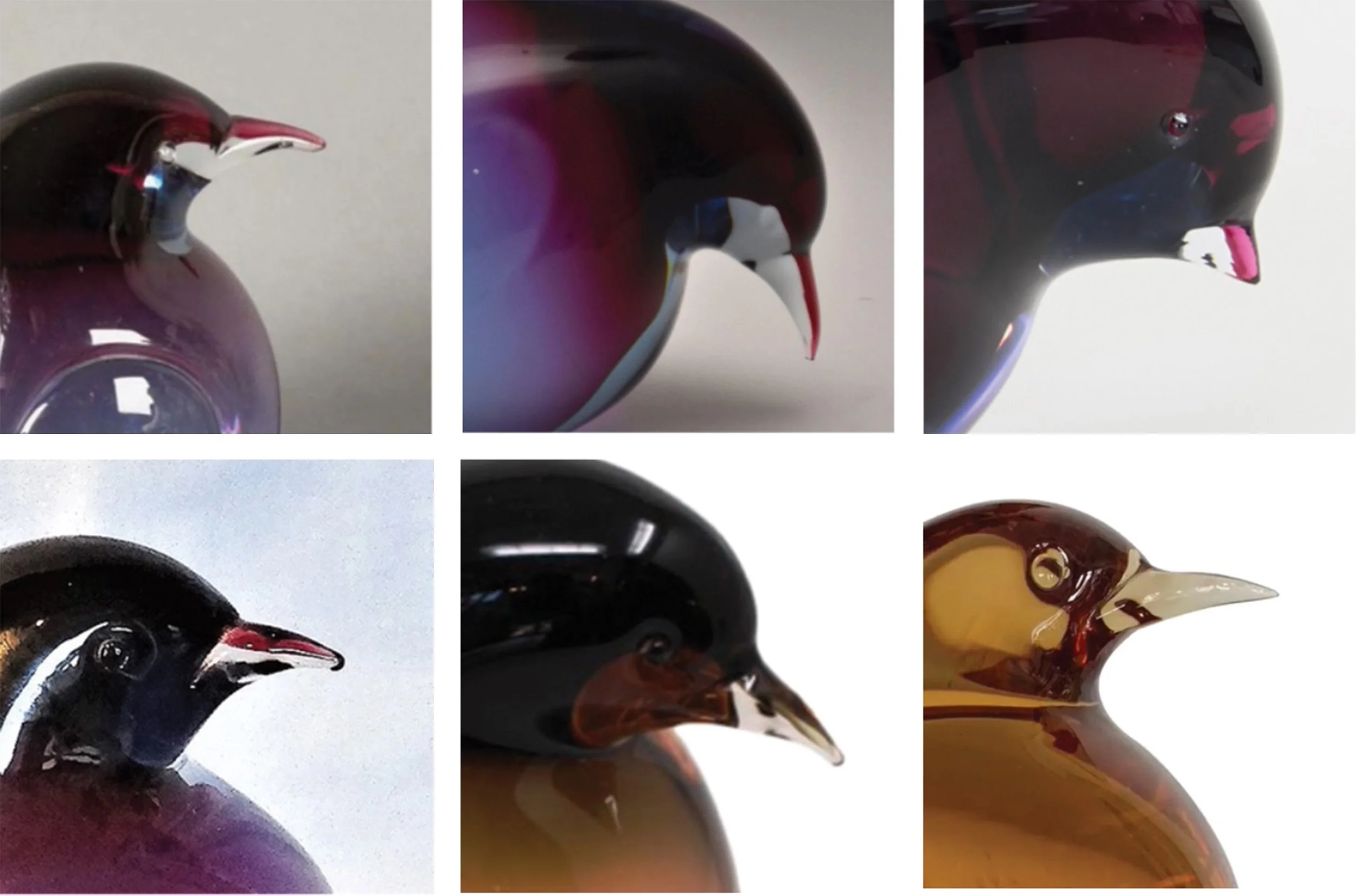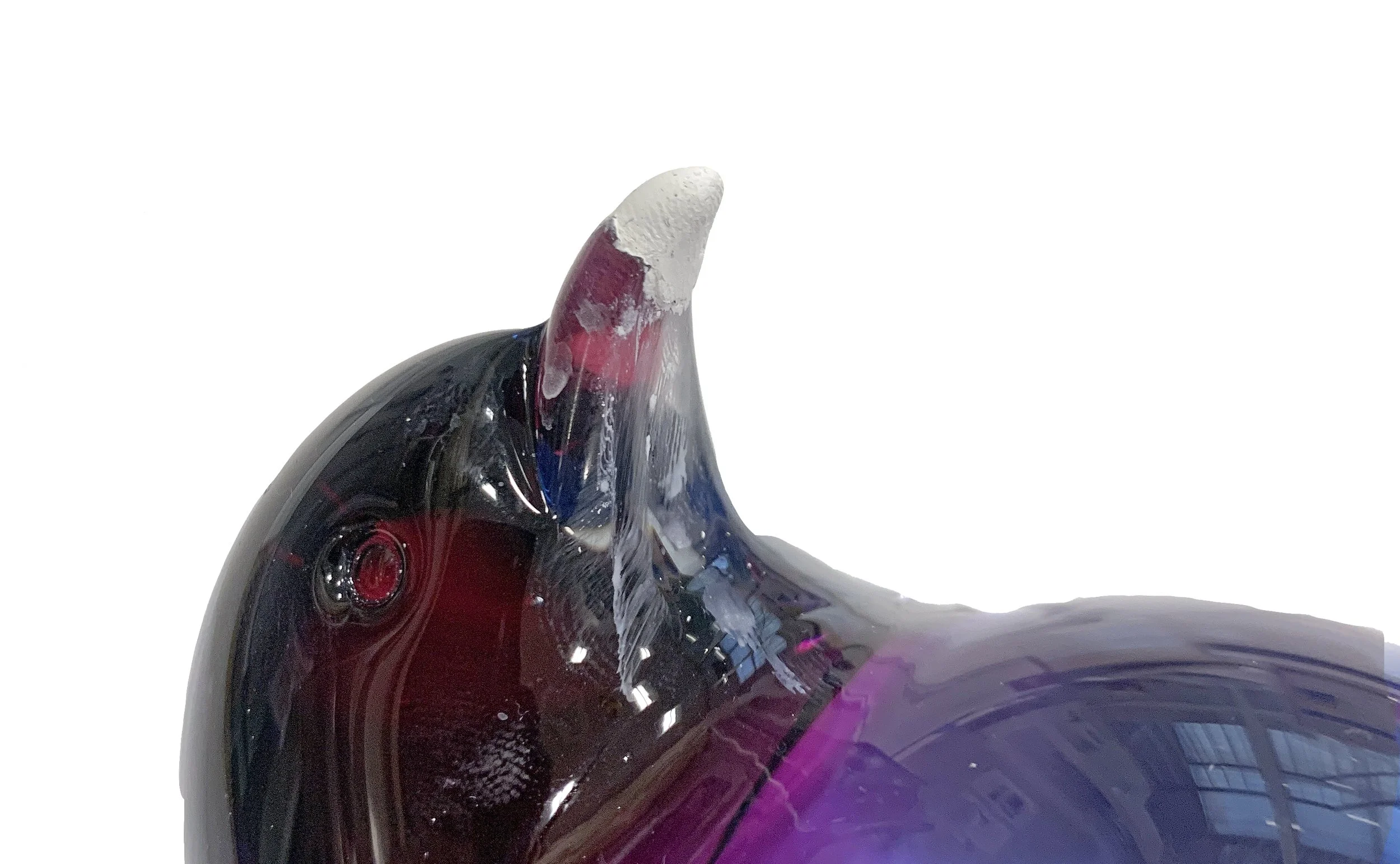From Break to Beak
Murano, Italy’s glassblowing capital off the coast of Venice, Italy has hosted many venerable families of glass artists over time. This 20th century bird sculpture of their creation arrived at the conservation studio with an appreciable loss to the tip of its beak. This ambitious project involved extensive experimentation with molds, dyes, and epoxies to create a replacement which was successfully integrated into the original object.
The glass bird arrived to the conservation studio with a noticeable loss to the tip its beak. While in stable condition, this loss was visually disturbing and interrupted the object’s clean, modern profile and the even dispersion of the violet colored glass.
Before Treatment
After Treatment
A replacement beak, modeled using an epoxy putty and cast using clear Hxtal NYL-1 epoxy resin, harmonizes the object’s form and brings it closer to its original appearance.
Initial Condition Assessment
The loss to the tip of the bird’s beak resulted in a series of concentric fractures and jagged edges which made the reintegration of a replacement beak a complex endeavor. Complicating the matter is the fact that the beak was created with a streak of violet colored glass running its length. Recreating the tip of the beak required a gapless join and extending the colored glass into the replacement.
Understanding the object and how it was made were important steps in weighing appropriate treatment options. Research showed that the sculpture was hand-made by gathering a glob of molten glass onto hollow steel pipe called a “pontil”. The tail and beak were hot-worked, pulled by hand from the shaped body while the glass was still molten.
The art of making bird figurines from molten glass goes back millennia. The earliest examples appear as Egyptian pendants, but as once the art of glassblowing became more widespread, the shape was adapted to be used for vessels for holding a variety of liquids (i.e., perfume). The Metropolitan Museum of Art’s Glass bottle shaped like a bird (Roman, ca. 1st century AD; MMA 74.51.206) is described as having a “drawn out at back to form stylized tail,” the same technique likely used in the creation of the beak of the Murano bird.
Art Historical Context
and Comparanda
An intermediary replacement beak was first sculpted in situ using Milliput epoxy putty over a barrier layer of 5% B72 adhesive resin solubilized in acetone. After this beak had cured, it was cast into a polyurethane rubber mold. Once the mold had cured, the epoxy putty intermediary was removed and a Hxtal NYL-1 epoxy cast was made.
Treatment
Moldmaking and Casting
Next began the process of refining the replacement beak’s final shape. This was done using a variety of increasing grit sandpaper and micromesh, ranging from 600 grit to 12,000 grit. Achieving a pleasing shape was extremely difficult and needed to be done in situ so that the form was monitored constantly. Once the shape was satisfactory, a single very thin layer of clear Hxtal NYL-1 epoxy was brushed onto the surface to achieve a glass-like finish.
Above, L to R: The epoxy putty intermediary beak, removed from the glass bird, with two wax sprues attachig it to a polystyrene sheet; the mold before polyurethane rubber; rubber poured into mold.
Shaping and Refining
Above: (Left): Using sanding sticks to shape the epoxy beak in situ. (Rright): A final coat of epoxy gave the beak a satisfying glass-like shine and clarity.
Above: Sandpaper and micromesh of increasingly fine grit was used to achieve a clear replacement beak.
To imitate the streak of pink colored glass which extended into the original beak, I experimented with Orasol dyes to introduce color into adhesive which was then brushed onto the top surface of the beak. The solvent was allowed to evaporate until a workable “paint-like” consistency was reached.
Introducing the PinkColor
Above, L to R: B72 adhesive resin cast into cups after being dyed using Orasol dyes; B72 solubilized in ethanol and dyed with Orasol dyes, the jar of dyed B72, a test streak of colored B72 applied to the replacement beak.
Completed Treatment
This ambitious project was technically very challenging. The treatment was considered a success given the complexity of the restoration and the bird is once again able to present as a modern, streamlined work of modern glass art.
Before
Treatment
After
Treatment



